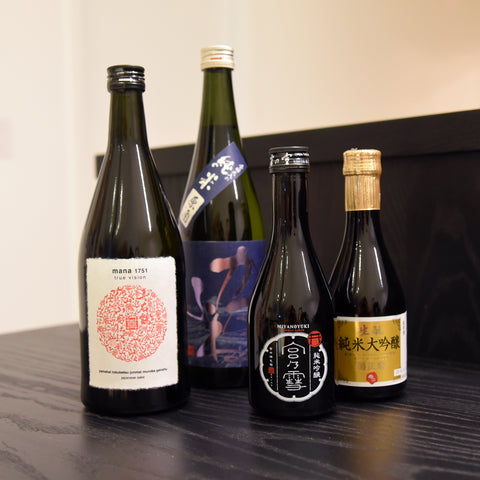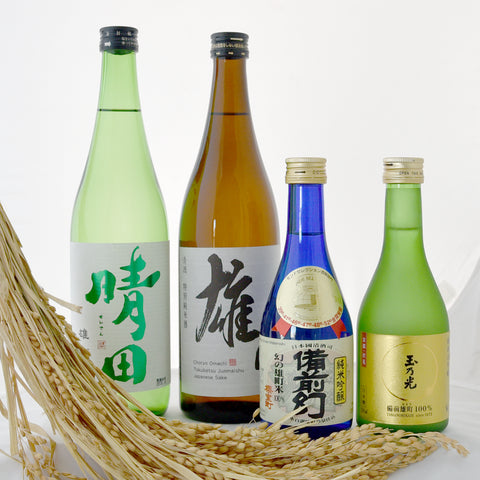
Orizake has always intrigued me. Ori, in Japanese, means bottom or lower. In the context of sake, orizake is a style of sake that incorporates the rice particles that settle at the bottom of the tank while aging.
The first time I encountered orizake was at Brooklyn Kura.

It was thick, bubbly, and yogurty. They served it in in a ceramic cup from an Erlenmeyer flask. It was unlike any sake I'd had before, and I wanted to try more.

During staff meal after the Kosuke Bistro Dinner at Soba Ichi last month, Yoshi Sako from Den Sake Brewery told us he has a "very special bottle" that he wanted us to try. From his bag, he pulled out a bottle with opaque, milky liquid. Naturally, I thought, "Oh, he's making a nigori!"

Nope, it was orizake!
It was reminiscent of the orizake I tried at Brooklyn Kura, but this one had more body and a little less effervescent, but still very lively. Sako said it was orizake from his latest Batch #6. I loved the yogurty tartness alongside the lamb that was served that night.
Orizake is quite rare. This may be because the majority of sake makers use a mechanized Yabuta press, which uses a very fine mesh and filters out all of the ori.
 Yabuta press at Aoki Brewery in Niigata
Yabuta press at Aoki Brewery in Niigata
It is more likely for ori to collect after pressing if the brewer uses a traditional pressing method like the Fune.
 Sako’s Fune press built by hand
Sako’s Fune press built by hand
This method is called hanegi-shibori or tenbin-shibori. Only a few breweries still use this technique in Japan. It’s a slow press and the resulting sake tends to be round and smooth in flavor. It takes two to three days to complete pressing for each tank.
The Fune press method is essentially a bunch of bags full of sake that look like pillows which are laid on top of each other in a wooden box. Gravity presses out the sake slowly as the pressure from the bags weigh each other down.

It's a much more labor-intensive pressing system than the Yabuta, which is a machine that presses out the a larger quantity of sake at a more aggressive and faster rate than Fune pressing.
At the Sake Dinner, Sako-san had an idea to release a limited amount (since he can only get a fraction of orizake from his total yield) for the opening of our first bar! We are so excited and honored to be the only place to offer Sako's orizake. He even named it "Umami Mart Ori" and will be exclusively poured and stocked on our shelves at our new bar.

I wanted to know more about Sako's method of making orizake. So we asked him a few questions about Umami Mart Ori.
How do you make orizake?
Once the sake is pressed in fine woven bags using our Fune, the sake is stored in a tank and sits there for five days. During those five days, fine sediment settles at the bottom of the tank. This process is called ori-sage (“racking” in wine terms).
Then, only the clear top part is taken out, transferred into an another vessel and bottled as regular sake. What's left is the cloudy orizake that settled at the bottom of the tank.
How much of the tank is the orizake?
Although it may vary depending on what kind of pressing system is used, the orizake is about 1/30 of the clear part in our case.
What is the difference between orizake and nigori? They look so similar yet taste different.
Nigori undergoes a different production process. During fermentation, some of the moromi (main mash including yeast, rice, koji, and water) is taken out, then it’s stored in colder climate (about 0 degrees Celsius) in order to stop the yeast activity. Since the yeast is not active, that moromi will stay sweet.
Once fermentation is done, the sake is pressed then the sweet moromi is added back to the pressed sake. That is why Nigori is normally sweet.
Orizake is not that sweet because the sediment is included all the way to the end of fermentation together with pressed sake. Additionally, orizake has much finer sediment, since bigger rice particles from the moromi are not added back in as in the case of nigori.
I love the bitterness of your orizake. It's almost similar to how matcha celebrates bitterness. Where does that bitterness come from?
Often times right after sake is pressed, there is a noticeable bitterness in it. I feel some of the bitterness becomes savory, umami over time. In general, the sediment contains more bitterness than the clear sake in the tank.
I really enjoyed that bitterness and yogurty flavors with the lamb dish we served at the sake dinner last month. How do you like to pair this orizake?
My recent surprisingly successful pairing was when I tried my orizake with a venison dish at the Abstract Table pairing dinner event here in Oakland. Something gamey or rich like beef would be great for a food pairing. The bitter component in my orizake may play a similar role as tannin in red wine.
What gave you the idea to bottle your orizake?
I heard that some breweries in Japan sell the sediment part as orizake. So I wanted to experiment with this idea and see how people would respond to it.
What do most breweries do with their orizake?
I think some breweries sell it, or keep it for themselves.
+++
We are so lucky that we are getting a taste of your orizake. Thank you Sako-san for doing what you do.
Since orizake is unpasteurized and raw, we can only offer it locally. If you are in Oakland, come try it at our tasting bar!
But don't forget, we do ship Den Sake's Junmai within California.

Thank you Lani, Yoshi, and Yuuki!




Comments (0)
There are no comments for this article. Be the first one to leave a message!